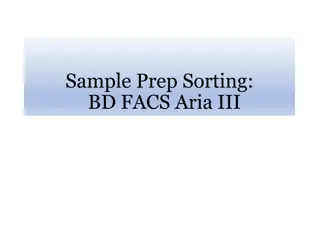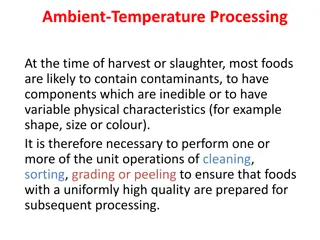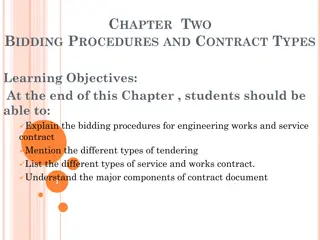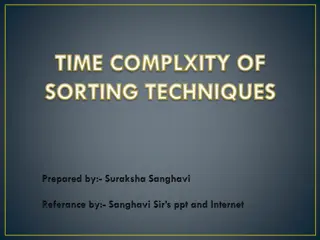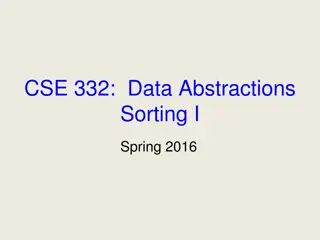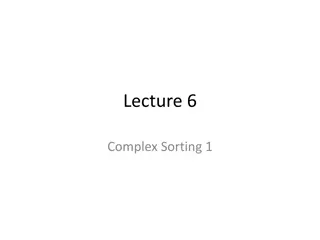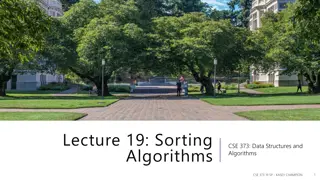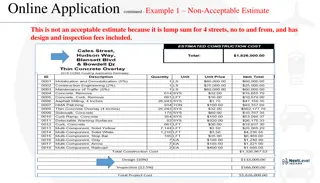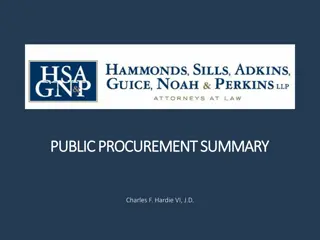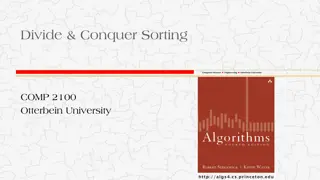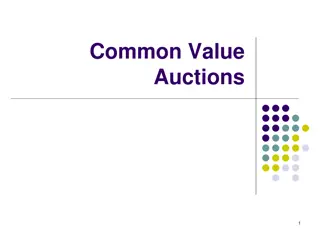Public Finance Seminar: Bidding and Sorting Class
Covering topics on allocative efficiency, equity, Tiebout model, and consensus in public finance, this seminar explores how households and communities make choices affecting local government services and property taxes.
Download Presentation

Please find below an Image/Link to download the presentation.
The content on the website is provided AS IS for your information and personal use only. It may not be sold, licensed, or shared on other websites without obtaining consent from the author.If you encounter any issues during the download, it is possible that the publisher has removed the file from their server.
You are allowed to download the files provided on this website for personal or commercial use, subject to the condition that they are used lawfully. All files are the property of their respective owners.
The content on the website is provided AS IS for your information and personal use only. It may not be sold, licensed, or shared on other websites without obtaining consent from the author.
E N D
Presentation Transcript
PUBLIC FINANCE SEMINAR PUBLIC FINANCE SEMINAR SPRING 2021, PROFESSOR YINGER SPRING 2021, PROFESSOR YINGER Bidding and Sorting
Bidding and Sorting Bidding and Sorting Class Outline Class Outline Bidding Sorting Allocative Efficiency and Equity
Bidding and Sorting Bidding and Sorting Class Outline Class Outline Bidding Bidding Sorting Allocative Efficiency and Equity
Bidding and Sorting Bidding and Sorting Class Overview Class Overview This class provides an intuitive overview of the concepts of bidding and sorting and the use of these concepts in understanding a system of local governments. A more formal treatment can be found in Ross and Yinger, Handbook of Regional and Urban Economics, Vol. 3, 1999.
Bidding and Sorting Bidding and Sorting Three Related Questions Three Related Questions How do households select a community in which to live? How do households select a community in which to live? =The subject of this class. =The subject of this class. How do communities select the levels of local public services and the property tax rate? (= Demand!) Under what conditions is the community-choice process compatible with the local voting process? (=General Equilibrium)
Bidding and Sorting Bidding and Sorting Tiebout Tiebout Charles Tiebout argued in a famous 1956 JPE article that people shop for a community, just as they shop for other things. This process came to be known as shopping with one s feet. The Tiebout model became very influential both because it identified an important type of behavior to be studied and because it concluded that the community-choice process is efficient efficient. Although Tiebout s model has neither a housing market nor a property tax, many people (not including me) still accept his efficiency claim, at least to a first approximation.
Bidding and Sorting Bidding and Sorting The Consensus Post The Consensus Post- -Tiebout Assumptions Assumptions Tiebout Model, Model, 1. Households care about housing, public services, and other goods. 2. Households fall into distinct income/taste classes. 3. Households are mobile (i.e. can move costlessly across jurisdictions). So an equilibrium cannot exist unless all people in a given income/taste class achieve the same level of satisfaction. 4. All households who live in a jurisdiction receive the same level of public services.
Bidding and Sorting Bidding and Sorting The Consensus Model, Assumptions, 2 The Consensus Model, Assumptions, 2 5. Residence in a jurisdiction is a precondition for the receipt of public services there (an assumption undermined by some education choice programs). 6. Public services are financed through a local property tax. 7. An urban area has many local jurisdictions, which have fixed boundaries and vary in their local public service quality and property tax rates. 8. Households are homeowners (or else they are renters and the property tax is shifted fully onto them through rents).
Bidding and Sorting Bidding and Sorting Bidding Bidding These assumptions describe a housing market in which households compete for access to the most desirable locations, i.e., those with the best combinations of public services and property tax rates. This competition takes the form of housing bids different types of household. bids, with different bids for Tiebout s article initiated this literature. This literature can reasonably be called the Tiebout literature. However, the consensus model is very different from the model in Tiebout, and it is not appropriate to describe the consensus model as the Tiebout model.
Bidding and Sorting Bidding and Sorting Bidding, 2 Bidding, 2 An analysis of bidding is based on 4 concepts: housing services, H, which can be Housing is measured in units of housing services thought of as quality-adjusted square feet. housing price, labeled P, is what a household bids The associated housing price per unit of H per year. rent for a housing unit, R, equals PH. If the unit is an The rent apartment, R = PH is equivalent to the annual rent. If the unit is owner-occupied, R is not observed but is implicit. The value value of a housing unit, V, is the amount someone would pay to own that unit; it equals the present value of the flow of net rental services associated with ownership or V = PH/r = R/r.
Bidding and Sorting Bidding and Sorting The Bid Function The Bid Function P is the amount a household is willing to pay per unit of H in a jurisdiction with service quality S and property tax rate t: P = P{S, t}. A bid function is defined for all values of S and t, regardless of whether or not these values are the ones a household actually experiences. We will have to do some more work to figure out market prices.
Bidding and Sorting Bidding and Sorting The Bid Function, 2 The Bid Function, 2 This logic is expressed in the following two figures. Figure 1 shows how bids (P) change as S changes (holding t constant). Figure 2 shows how bids change as t changes (holding S constant) These curves hint at the idea that housing prices reflect S and t but we are not quite there yet.
Bidding and Sorting Bidding and Sorting Figure 1: Housing Bids as a Function of Public Service Quality Figure 1: Housing Bids as a Function of Public Service Quality (Holding the Property Tax Rate Constant) (Holding the Property Tax Rate Constant) P S
Bidding and Sorting Bidding and Sorting Figure 2: Housing Bids as a Function of the Property Tax Figure 2: Housing Bids as a Function of the Property Tax Rate Rate (Holding Public Service Quality Constant) (Holding Public Service Quality Constant) P t
Bidding and Sorting Bidding and Sorting Questions Questions What are the key assumptions behind the post-Tiebout consensus. What is a bid function for public services?
Bidding and Sorting Bidding and Sorting Class Outline Class Outline Bidding Sorting Sorting Allocative Efficiency and Equity
Bidding and Sorting Bidding and Sorting Sorting Sorting If all household are alike, then Figures 1 and 2 describe market outcomes; in equilibrium housing prices will adjust to exactly compensate households who end up in low-S or high-t jurisdictions. This compensation idea is a key to the intuition. But obviously households are not all alike, and different types of households must sort sort across jurisdictions.
Bidding and Sorting Bidding and Sorting Sorting and Slopes Sorting and Slopes The key idea in the consensus model is that households sort according to the steepness of their bid functions. The slope is P/ S; a steeper slope corresponds to a greater willingness to pay (WTP) for an increment in S i.e. to a greater marginal willingness to pay (MWTP). Housing sellers prefer to sell to the highest bidder, so a steeper slope wins where S is higher.
Bidding and Sorting Bidding and Sorting Sorting and Slopes, 2 Sorting and Slopes, 2 Note that in the long run sellers prefer the highest P, not the highest PH. H can be adjusted by adding on to a housing unit or dividing it into smaller units. The seller wants the highest return per unit of H, which is given by P.
Bidding and Sorting Bidding and Sorting Figure 3: Consensus Bidding and Sorting Figure 3: Consensus Bidding and Sorting P P3 Household type 3 s bid function P2 P1 S2 S2 S1 S
Bidding and Sorting Bidding and Sorting The Bid The Bid- -Function Envelope Function Envelope In Figure 3, the observed market price function is the envelope underlying bid functions, say PE. In other words, the price function is the set of winning bids. envelope of the This function shows how S and t show up in housing prices. This phenomenon is known as capitalization with the impact of annual flows S and t ) on the value of a capital asset (a house). capitalization, because it has to do As we will see, many studies estimate capitalization! As we will see, the equation for an envelope is also called a hedonic function.
Bidding and Sorting Bidding and Sorting Sorting and Bid Sorting and Bid- -Function Heights Function Heights One subtle point in Figure 3 is that the heights adjust so that each type of household has enough room. heights of the bid functions To get the logic right, start with a point at which the bid functions of two groups intersect i.e., their heights are the same. From this starting point, it is obvious that the group with the steeper bid function bids more where S is higher. It is impossible to shift the heights around so that (a) both groups live somewhere and (b) the group with the flatter slope lives where S is higher.
Bidding and Sorting Bidding and Sorting The Single The Single- -Crossing Condition Crossing Condition It is logically possible for household type A to have a steeper bid function than household type B at one value of S and for a household type B to have a steeper bid function at a different value of S. In this case it may be impossible to find an equilibrium. Almost all scholars rule out this case with the so-called single- crossing condition, which is that if household type A has a steeper bid function than household type B at one value of S, it also has a steeper bid function at any other value of S. Bid functions are iso-utility curves, so this assumption is equivalent to a regularity condition on the underlying utility functions.
Bidding and Sorting Bidding and Sorting Sorting and Empirical Research Sorting and Empirical Research Figure 3 has 2 key implications for empirical work. First, any estimate of the impact of S on P (or on R or V) blends willingness to pay (movement along a bid function) and sorting (shifting across bid functions for different household types). In Figure 3, for example, (P3 P1) does not measure any group s WTP for S3 versus S1. It is very difficult to untangle these two effects!
Bidding and Sorting Bidding and Sorting Sorting and Empirical Research, 2 Sorting and Empirical Research, 2 Second, the market relationship between S and P, that is, the envelope, is very unlikely to be linear (or even log-linear). Because sorting is based on bid-function slopes, the slope of the winning bidder (the one we observe) goes up as the level of S increases. Figure 4 gives a simple example with linear bid functions (which correspond to a constant MWTP, which is equivalent to a horizontal demand curve). But Figure 5 shows that the envelope may still have a declining slope.
Bidding and Sorting Bidding and Sorting Figure 4: A Nonlinear Envelope with Linear Bid Functions Figure 4: A Nonlinear Envelope with Linear Bid Functions P{S} S
Bidding and Sorting Bidding and Sorting Figure 5: A Nonlinear Envelope with Nonlinear Bid Figure 5: A Nonlinear Envelope with Nonlinear Bid Functions Functions Bid per Unit of Housing Services (Log) Hedonic Envelope Bid Functions 0 10 20 30 40 50 60 70 80 90 100 Amenity (e.g. School Test Passing Rate) You can plot different envelopes using spreadsheet posted on the main page of my website,
Bidding and Sorting Bidding and Sorting Normal Sorting Normal Sorting Under normal circumstances, higher-income households will pay more for an increment in S. See Figure 6, where MB = MWTP(and a 2 subscript indicates high-income). So high-income households will normally win the competition in high-S jurisdictions. Low-income households win the competition in low-S jurisdictions because they are willing to accept low H, e.g. by doubling up, and hence can bid a lot per unit of H.
Bidding and Sorting Bidding and Sorting Figure 6: The Demand for Local Public Services Figure 6: The Demand for Local Public Services D2 = MB2
Bidding and Sorting Bidding and Sorting Normal Sorting, 2 Normal Sorting, 2 The formal condition for normal sorting is that the ratio of the income and elasticities of demand for S must exceed the income elasticity of demand for H . Note that matters because a household s willingness to pay for S (and hence its bid) is spread out over the number of units of H it buys. The empirical literature suggests that this condition is usually met.
Bidding and Sorting Bidding and Sorting Questions Questions What is sorting? What is normal sorting? How does the logic of sorting affect the interpretation of a capitalization equation (also called a hedonic regression)? Why is a linear hedonic equation inappropriate?
Bidding and Sorting Bidding and Sorting Class Outline Class Outline Bidding Sorting Allocative Allocative Efficiency and Equity Efficiency and Equity
Bidding and Sorting Bidding and Sorting Sorting and Inequality Sorting and Inequality Sorting results in a system of local governments in which some jurisdictions are much wealthier than others. Moreover, as discussed earlier in the class, the cost of public services is often linked to poverty. The overall result is a federal system in which both resources and costs are unevenly distributed and in which higher-income people receive higher levels of S. The key normative tradeoff: community choice versus equality of opportunity.
Bidding and Sorting Bidding and Sorting Sorting and Inequality, 2 Sorting and Inequality, 2 One way to show the link between sorting and inequality is to obtain a measure of what people bid for all neighborhood attributes put together and then determine whether this measure is linked to income. Some evidence of this type comes from the neighborhood measure in my 2015 JUE article (more later on the estimating method). Figure 7 shows that this link is very strong! Note: In this figure, income is the income of households receiving mortgages; the Home Mortgage Disclosure Act (HMDA) data is the source of this variable.
Bidding and Sorting Bidding and Sorting Sorting and Inequality, 2 Sorting and Inequality, 2 Figure 7: Income and Neighborhood Quality 13 12.5 12 11.5 11 10.5 9 10 11 12 13 Log of Adjusted HMDA Income Log of Neighborhood Quality Fitted values
Bidding and Sorting Bidding and Sorting Heterogeneity Within a Jurisdiction Heterogeneity Within a Jurisdiction Sorting implies a tendency for jurisdictions to be homogeneous by income. But this homogeneity is not complete: Other factors influence demand. Heterogeneous communities arise where bid functions cross. The next slide revises Figure 3. Many household types could live in a large jurisdiction.
Bidding and Sorting Bidding and Sorting Figure 8: Heterogeneity with Consensus Bidding and Figure 8: Heterogeneity with Consensus Bidding and Sorting Sorting P P3 P2 Four household types live in the jurisdiction where S = S1. P1 4 1 3 2 S2 S2 S1 S
Bidding and Sorting Bidding and Sorting Sorting and Tax Rates Sorting and Tax Rates Figures 3 and 8 hold t constant. In fact, t does not affect sorting. Any household is willing to pay $1 to avoid $1 of property taxes (or to bid 1% more in a location where t is 1% lower). Sorting only involves S. Nevertheless, sorting is sometimes shown with net bids that reflect both S and t. See Figure 9. Eventually these net bid functions turn town as the marginal benefit from S falls short of the tax cost.
Bidding and Sorting Bidding and Sorting Figure 9: Consensus Bidding and Sorting Net of Taxes Figure 9: Consensus Bidding and Sorting Net of Taxes P P3 P2 P1 Y3 Y2 Y1 Y
Bidding and Sorting Bidding and Sorting The Hamilton Approach The Hamilton Approach Bruce Hamilton (Urban Studies 1975) developed a Tiebout-like model with housing and a property tax based on three crucial assumptions: Housing supply is elastic (presumably by movement in jurisdictions boundaries). Zoning is set at exactly the optimal level of housing for the residents of a jurisdiction. Government services are produced at a constant cost per household.
Bidding and Sorting Bidding and Sorting Hamilton, 2 Hamilton, 2 The striking implication of the Hamilton assumptions is that capitalization disappears. See Figure 6. Everyone ends up in their most-preferred jurisdiction, so nobody bids up the price in any other jurisdiction. This prediction (no capitalization) is rejected by all the evidence (to be covered in future classes).
Bidding and Sorting Bidding and Sorting Figure 10: Hamilton Bidding and Sorting Figure 10: Hamilton Bidding and Sorting P _ P Y3 Y2 Y1 Y
Bidding and Sorting Bidding and Sorting Is a Federal System Efficient? Is a Federal System Efficient? Tiebout (with no housing or property tax) said picking a community is like shopping for a shirt and is therefore efficient (in the allocative sense). This result is replicated with a housing market and a property tax under the Hamilton assumptions. These assumptions are extreme and the model is rejected by the evidence.
Bidding and Sorting Bidding and Sorting Sources of Inefficiency Sources of Inefficiency 1. Heterogeneity Heterogeneity leads to inefficient levels of local public services. Outcomes are determined by the median voter; voters with different preferences experience dead-weight losses compared with having their own jurisdiction. See Figure 7.
Bidding and Sorting Bidding and Sorting Figure 11: Inefficiency Due to Heterogeneity Figure 11: Inefficiency Due to Heterogeneity
Bidding and Sorting Bidding and Sorting Heterogeneity in Services? Heterogeneity in Services? The consensus model assumes that all households in a jurisdiction receive the same services. This is not true; higher-income neighborhoods have better police protection and probably better elementary schools, for example. This eliminates some of the inefficiency in Figure 7 but adds to inequality. This topic is poorly understood; research is needed!
Bidding and Sorting Bidding and Sorting Sources of Inefficiency Sources of Inefficiency 2. The Property Tax Producers of housing base their decisions on P, whereas buyers respond to P(1 + t/r), (which, as we will see, is constant across jurisdictions). This introduces a so-called tax wedge between producer and consumer decisions, which leads to under-consumption of housing.
Bidding and Sorting Bidding and Sorting Hamilton and Inefficiency Hamilton and Inefficiency These two sources of inefficiency disappear in Hamilton s model: Boundaries adjust so that all jurisdictions are homogeneous (despite extensive evidence that boundaries do not change for this reason). Zoning is set so that housing consumption is optimal (despite the incentives of residents to set zoning above their housing level so new residents pay more).
Bidding and Sorting Bidding and Sorting Conclusions on Efficiency Conclusions on Efficiency The Hamilton model shows how extreme the assumptions must be to generate an efficient outcome. Nevertheless, most scholars defend our federal system as efficient, Instead of identifying policies, such as intergovernmental aid programs, to improve its efficiency.
Bidding and Sorting Bidding and Sorting Questions Questions Why might an equilibrium sorting outcome be considered unfair? Under what conditions might a sorting outcome be considered efficient (in the allocative sense)?





